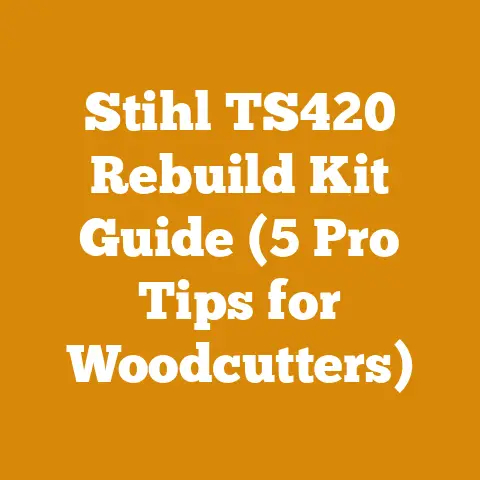Stihl Kombi Storage Rack Solutions (5 Pro Setups for Firewood Pros)
Let’s face it, as a seasoned firewood pro, I know that a well-organized workspace is paramount. That’s why the Stihl KombiSystem is a game-changer – the versatility is unmatched. But all those attachments can quickly turn your shed into a chaotic mess. That’s where a dedicated storage solution comes in. In my experience, the best option is a customizable system that adapts to your specific Kombi attachments and space constraints. This guide will dive into five pro-level storage setups for your Stihl KombiSystem, specifically tailored for firewood professionals like you and me. I’ll share my insights, learned from years of experience, to help you maximize efficiency and keep your gear in top shape.
Stihl Kombi Storage Rack Solutions (5 Pro Setups for Firewood Pros)
Keeping my Stihl KombiSystem organized has always been a challenge. Over the years, I’ve experimented with various storage solutions, some successful, others not so much. Through trial and error, I’ve developed a few go-to setups that keep my attachments secure, accessible, and in good working order. These solutions are designed to maximize space, improve efficiency, and protect your investment.
Why Proper Storage Matters for Your Stihl KombiSystem
Before we dive into the setups, let’s talk about why proper storage is essential. Improper storage can lead to several issues, including:
- Damage to Attachments: Leaving attachments exposed to the elements can cause rust, corrosion, and other damage.
- Reduced Lifespan: Neglecting proper storage can shorten the lifespan of your valuable tools.
- Safety Hazards: Cluttered workspaces are dangerous. Tripping over attachments or struggling to find the right tool can lead to accidents.
- Inefficiency: Wasting time searching for the right attachment is a productivity killer.
- Increased Maintenance: Damaged or poorly stored attachments require more frequent maintenance and repairs.
Investing in a good storage system is an investment in the longevity, safety, and efficiency of your Stihl KombiSystem. It’s a small price to pay for the peace of mind and improved workflow it provides.
Setup 1: The Wall-Mounted Organizer – My Go-To for Small Spaces
When space is at a premium, a wall-mounted organizer is your best bet. This setup utilizes vertical space, keeping your attachments off the floor and within easy reach. It’s my personal favorite for smaller sheds or garages.
Components Needed:
- Heavy-Duty Pegboard: Choose a pegboard made from metal or durable plastic. I recommend a size of at least 4ft x 4ft.
- Pegboard Hooks: A variety of hooks in different sizes and shapes to accommodate your attachments. I prefer coated hooks to prevent scratching.
- Wall Mounting Hardware: Ensure you have the appropriate screws, anchors, and brackets for your wall type.
- Measuring Tape: For accurate placement of hooks and attachments.
- Level: To ensure the pegboard is mounted straight.
- Optional:
- Small shelves for storing oils, lubricants, and other supplies.
- Labels for identifying each attachment.
Assembly and Setup:
- Measure and Mark: Determine the location for your pegboard and mark the stud locations on the wall. Use a stud finder to ensure accuracy.
- Mount the Pegboard: Securely mount the pegboard to the wall using the appropriate hardware. Ensure it is level.
- Arrange Attachments: Lay out your attachments on the floor and experiment with different arrangements to maximize space and accessibility.
- Install Hooks: Based on your arrangement, install the pegboard hooks to hold each attachment securely.
- Hang Attachments: Hang your attachments on the hooks, ensuring they are stable and easily accessible.
- Add Shelves (Optional): Install small shelves to store oils, lubricants, and other supplies.
- Label (Optional): Label each attachment for easy identification.
Pro Tips:
- Use a variety of hook sizes: Different attachments require different hook sizes. Invest in a variety pack to ensure you have the right hooks for each tool.
- Consider weight distribution: Distribute the weight evenly across the pegboard to prevent it from sagging or pulling away from the wall.
- Leave space between attachments: Don’t overcrowd the pegboard. Leave enough space between attachments for easy access.
- Regularly inspect hooks: Check the hooks regularly for wear and tear. Replace any damaged or weakened hooks immediately.
Cost and Time Estimate:
- Cost: \$50 – \$150, depending on the size and quality of the pegboard and hooks.
- Time: 1-2 hours.
My Experience:
I’ve been using a wall-mounted organizer for my Stihl KombiSystem for years. It’s a fantastic space-saver, and it keeps my attachments organized and accessible. I especially appreciate the ability to customize the arrangement as my collection of attachments grows. I’ve found that using coated hooks is essential to prevent scratches on my tools.
Takeaway:
A wall-mounted organizer is an excellent option for small spaces. It’s customizable, affordable, and easy to install. It’s a great way to keep your Stihl KombiSystem attachments organized and accessible.
Setup 2: The Mobile Cart – For Maximum Flexibility
If you need to move your Stihl KombiSystem attachments around your property, a mobile cart is the perfect solution. This setup provides maximum flexibility and allows you to bring your tools wherever you need them. I’ve used this setup extensively when working on large properties where I need to move my tools frequently.
Components Needed:
- Heavy-Duty Utility Cart: Choose a cart with sturdy wheels and a weight capacity that can handle your attachments. I recommend a cart with a metal frame and a durable plastic or metal bed.
- Pegboard or Mesh Panels: Attach pegboard or mesh panels to the sides of the cart to create storage for your attachments.
- Pegboard Hooks or S-Hooks: A variety of hooks to hang your attachments.
- Bungee Cords or Straps: To secure attachments during transport.
- Tool Holders: For storing the Kombi engine and other tools.
- Optional:
- Lockable storage compartment for securing valuable items.
- Power strip for charging batteries.
Assembly and Setup:
- Assemble the Cart: Assemble the utility cart according to the manufacturer’s instructions.
- Attach Pegboard/Mesh Panels: Attach pegboard or mesh panels to the sides of the cart using screws or bolts.
- Install Hooks: Install pegboard hooks or S-hooks to hang your attachments.
- Arrange Attachments: Arrange your attachments on the cart, ensuring they are secure and easily accessible.
- Secure Attachments: Use bungee cords or straps to secure attachments during transport.
- Add Tool Holders: Install tool holders for the Kombi engine and other tools.
- Add Optional Features: Install a lockable storage compartment or a power strip, if desired.
Pro Tips:
- Choose a cart with large wheels: Large wheels will make it easier to maneuver the cart over rough terrain.
- Use bungee cords to secure attachments: Bungee cords will prevent attachments from falling off the cart during transport.
- Consider a cart with a lockable storage compartment: A lockable storage compartment will protect your valuable items from theft.
- Regularly check the wheels: Check the wheels regularly for wear and tear. Replace any damaged or worn wheels immediately.
Cost and Time Estimate:
- Cost: \$100 – \$300, depending on the size and quality of the cart and accessories.
- Time: 2-3 hours.
My Experience:
The mobile cart has been a lifesaver on numerous jobs. It allows me to keep all my Stihl KombiSystem attachments organized and readily available, no matter where I am on the property. I highly recommend investing in a cart with large, durable wheels – it makes a huge difference when navigating uneven terrain. Securing the attachments with bungee cords is a must to prevent them from bouncing around during transport.
Takeaway:
A mobile cart is an excellent option for those who need to move their Stihl KombiSystem attachments around their property. It provides maximum flexibility and keeps your tools organized and accessible.
Setup 3: The Custom-Built Rack – Tailored to Your Specific Needs
For the ultimate in organization and customization, consider building a custom rack for your Stihl KombiSystem attachments. This setup allows you to design a storage solution that perfectly fits your specific needs and space constraints. I built my first custom rack years ago, and it was a game-changer in terms of efficiency and organization.
Components Needed:
- Lumber: Choose lumber that is strong and durable. I recommend using pressure-treated lumber for outdoor applications.
- Screws or Nails: Use screws or nails to assemble the rack.
- Drill: For drilling pilot holes and driving screws.
- Saw: For cutting lumber to the desired lengths.
- Measuring Tape: For accurate measurements.
- Level: To ensure the rack is level.
- Pegboard or Metal Strips: To create attachment points.
- Hooks or Brackets: To hold your attachments.
- Optional:
- Paint or stain to protect the wood and improve the appearance.
- Casters for mobility.
Assembly and Setup:
- Design the Rack: Design a rack that meets your specific needs and space constraints. Consider the size and shape of your attachments, the amount of space you have available, and the desired level of accessibility.
- Cut the Lumber: Cut the lumber to the desired lengths based on your design.
- Assemble the Rack: Assemble the rack using screws or nails. Ensure the rack is sturdy and level.
- Attach Pegboard/Metal Strips: Attach pegboard or metal strips to the rack to create attachment points.
- Install Hooks/Brackets: Install hooks or brackets to hold your attachments.
- Arrange Attachments: Arrange your attachments on the rack, ensuring they are secure and easily accessible.
- Paint/Stain (Optional): Paint or stain the rack to protect the wood and improve the appearance.
- Add Casters (Optional): Add casters to the rack for mobility.
Pro Tips:
- Use pressure-treated lumber for outdoor applications: Pressure-treated lumber will resist rot and decay.
- Design the rack to fit your specific needs: Consider the size and shape of your attachments, the amount of space you have available, and the desired level of accessibility.
- Use sturdy construction techniques: Ensure the rack is sturdy and can support the weight of your attachments.
- Consider adding casters for mobility: Casters will make it easier to move the rack around your property.
Cost and Time Estimate:
- Cost: \$75 – \$200, depending on the type of lumber and hardware used.
- Time: 4-8 hours.
My Experience:
Building a custom rack was a rewarding experience. It allowed me to create a storage solution that perfectly fit my needs. I used pressure-treated lumber and sturdy construction techniques to ensure the rack would last for years. I also added casters to make it easy to move the rack around my workshop. The key is to plan meticulously and take accurate measurements.
Takeaway:
A custom-built rack is an excellent option for those who want a storage solution that is perfectly tailored to their specific needs. It requires more time and effort than other options, but the results are well worth it.
Setup 4: The Repurposed Pallet Rack – Budget-Friendly and Eco-Conscious
If you’re looking for a budget-friendly and eco-conscious storage solution, consider repurposing a pallet rack. Pallet racks are readily available and can be easily modified to create a functional and attractive storage system for your Stihl KombiSystem attachments. I’ve salvaged and repurposed pallets for various projects over the years, and they can be surprisingly versatile.
Components Needed:
- Pallet: Choose a pallet that is in good condition and free of splinters and nails.
- Saw: For cutting the pallet to the desired size and shape.
- Screws or Nails: Use screws or nails to assemble the rack.
- Drill: For drilling pilot holes and driving screws.
- Sandpaper: For smoothing rough edges.
- Pegboard or Metal Strips: To create attachment points.
- Hooks or Brackets: To hold your attachments.
- Optional:
- Paint or stain to protect the wood and improve the appearance.
- Casters for mobility.
Assembly and Setup:
- Prepare the Pallet: Inspect the pallet for any damage and remove any splinters or nails. Sand the pallet to smooth rough edges.
- Cut the Pallet: Cut the pallet to the desired size and shape using a saw.
- Assemble the Rack: Assemble the rack using screws or nails. Ensure the rack is sturdy and level.
- Attach Pegboard/Metal Strips: Attach pegboard or metal strips to the rack to create attachment points.
- Install Hooks/Brackets: Install hooks or brackets to hold your attachments.
- Arrange Attachments: Arrange your attachments on the rack, ensuring they are secure and easily accessible.
- Paint/Stain (Optional): Paint or stain the rack to protect the wood and improve the appearance.
- Add Casters (Optional): Add casters to the rack for mobility.
Pro Tips:
- Choose a pallet that is in good condition: Avoid pallets that are cracked, warped, or have missing pieces.
- Sand the pallet to smooth rough edges: Sanding will prevent splinters and make the rack more comfortable to handle.
- Use sturdy construction techniques: Ensure the rack is sturdy and can support the weight of your attachments.
- Consider adding casters for mobility: Casters will make it easier to move the rack around your property.
Cost and Time Estimate:
- Cost: \$20 – \$75, depending on the cost of the pallet and hardware.
- Time: 3-6 hours.
My Experience:
Repurposing a pallet rack is a great way to save money and reduce waste. I found a sturdy pallet at a local construction site and transformed it into a functional storage rack for my Stihl KombiSystem attachments. It took some elbow grease to prepare the pallet, but the end result was well worth the effort. Just be sure to thoroughly inspect the pallet for any hidden nails or staples.
Takeaway:
A repurposed pallet rack is an excellent option for those who are looking for a budget-friendly and eco-conscious storage solution. It requires some effort to prepare the pallet, but the end result is a functional and attractive storage system.
Setup 5: The Simple Hanging System – Quick and Easy
For a quick and easy storage solution, consider a simple hanging system. This setup involves hanging your Stihl KombiSystem attachments from hooks or straps attached to a wall or ceiling. It’s a great option for those who need a basic storage solution without a lot of fuss. I often use this method for attachments that I use frequently, as it allows for quick access.
Components Needed:
- Hooks or Straps: Choose hooks or straps that are strong enough to support the weight of your attachments. I recommend using heavy-duty hooks or straps with a weight capacity of at least 50 lbs per attachment.
- Wall or Ceiling Mounting Hardware: Ensure you have the appropriate screws, anchors, and brackets for your wall or ceiling type.
- Measuring Tape: For accurate placement of hooks or straps.
- Level: To ensure the hooks or straps are mounted straight.
Assembly and Setup:
- Measure and Mark: Determine the location for your hooks or straps and mark the stud locations on the wall or ceiling. Use a stud finder to ensure accuracy.
- Mount Hooks/Straps: Securely mount the hooks or straps to the wall or ceiling using the appropriate hardware. Ensure they are level.
- Hang Attachments: Hang your attachments from the hooks or straps, ensuring they are stable and easily accessible.
Pro Tips:
- Use heavy-duty hooks or straps: Ensure the hooks or straps are strong enough to support the weight of your attachments.
- Mount hooks/straps to studs: Mounting the hooks or straps to studs will provide the strongest support.
- Leave space between attachments: Don’t overcrowd the hooks or straps. Leave enough space between attachments for easy access.
- Regularly inspect hooks/straps: Check the hooks or straps regularly for wear and tear. Replace any damaged or weakened hooks or straps immediately.
Cost and Time Estimate:
- Cost: \$10 – \$30, depending on the type of hooks or straps used.
- Time: 30 minutes – 1 hour.
My Experience:
The simple hanging system is my go-to for attachments that I use frequently. It’s quick, easy, and doesn’t require a lot of space. I use heavy-duty hooks mounted to studs in my shed to hang my most-used attachments. The key is to ensure the hooks are securely mounted and can support the weight of the attachments.
Takeaway:
A simple hanging system is an excellent option for those who need a quick and easy storage solution. It’s affordable and doesn’t require a lot of space. It’s a great way to keep your Stihl KombiSystem attachments off the floor and within easy reach.
Maintaining Your Stihl KombiSystem Attachments
No matter which storage solution you choose, it’s essential to maintain your Stihl KombiSystem attachments properly. Regular maintenance will extend the lifespan of your tools and ensure they are always ready to perform.
Cleaning:
- Clean attachments after each use: Remove any dirt, debris, or sap from the attachments.
- Use a brush or cloth: Use a brush or cloth to clean the attachments.
- Avoid using harsh chemicals: Harsh chemicals can damage the attachments.
Lubrication:
- Lubricate moving parts regularly: Lubricate moving parts, such as gears and bearings, with a high-quality lubricant.
- Use the recommended lubricant: Use the lubricant recommended by Stihl.
- Apply lubricant sparingly: Apply lubricant sparingly to avoid attracting dirt and debris.
Sharpening:
- Sharpen cutting blades regularly: Sharpen cutting blades, such as those on the brushcutter and edger attachments, regularly to maintain optimal performance.
- Use the appropriate sharpening tools: Use the appropriate sharpening tools for each attachment.
- Follow the manufacturer’s instructions: Follow the manufacturer’s instructions for sharpening.
Inspection:
- Inspect attachments regularly for damage: Inspect attachments regularly for damage, such as cracks, dents, or loose parts.
- Repair or replace damaged parts: Repair or replace any damaged parts immediately.
- Check for wear and tear: Check for wear and tear on all parts of the attachments.
Storage:
- Store attachments in a dry place: Store attachments in a dry place to prevent rust and corrosion.
- Protect attachments from the elements: Protect attachments from the elements, such as rain, snow, and sunlight.
- Use a storage rack or container: Use a storage rack or container to keep attachments organized and protected.
Safety Considerations
When handling and storing your Stihl KombiSystem attachments, it’s essential to prioritize safety. Follow these safety guidelines to prevent accidents and injuries:
- Wear appropriate safety gear: Wear appropriate safety gear, such as gloves, safety glasses, and hearing protection, when handling and using your attachments.
- Read the owner’s manual: Read the owner’s manual carefully before using any attachment.
- Follow the manufacturer’s instructions: Follow the manufacturer’s instructions for using and maintaining your attachments.
- Keep children and pets away: Keep children and pets away from your work area.
- Disconnect the spark plug: Disconnect the spark plug before performing any maintenance or repairs.
- Store attachments safely: Store attachments in a safe and secure location, out of reach of children and pets.
- Be aware of your surroundings: Be aware of your surroundings and avoid working in hazardous conditions.
- Take breaks when needed: Take breaks when needed to avoid fatigue and maintain focus.
- Never operate equipment under the influence: Never operate equipment under the influence of alcohol or drugs.
- If in doubt, ask for help: If you are unsure about how to use or maintain your attachments, ask for help from a qualified professional.
Conclusion: Choosing the Right Storage Solution for You
Choosing the right storage solution for your Stihl KombiSystem attachments depends on several factors, including your budget, space constraints, and personal preferences. Consider the pros and cons of each setup before making a decision. Remember that proper storage is an investment in the longevity, safety, and efficiency of your tools. By implementing one of these pro-level storage solutions, you’ll be well on your way to a more organized and productive firewood operation. I hope my experiences and insights have been helpful in guiding you towards the perfect storage solution for your needs. Now, get out there and get organized!






